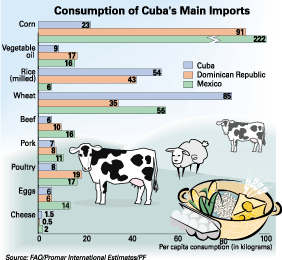
Nevertheless, 2000's prosperity was a boon to grocery stores, which accounted for 95% of the year's dollar sales as of December 1. The total for groceries was a 5.8% jump over the previous year, but December's sales showed some weakness--only 1.3% higher than December 1999.
Continuing the generally positive note, the Food Institute has preliminary estimates of meat and seafood market sales for the year, which were also ahead of year-ago figures--by some 6.2%--and finished at $6.8 billion. Retail bakery sales rose 5.8% to $7.6 billion, according to the Food Institute, and the $11.3 billion in sales in specialized food stores was 19% stronger than 1999.
The success for the food industry in 2000 was not solely in supermarkets, as the Bureau of Census and the Food Institute estimate restaurants achieved sales in the range of $300 billion for the year--a 9.0% gain.

Opening Doors to the Cuban Market
Since the 1960s, the U.S. has maintained a closed-door policy toward the Cuban market, but there are hints that the situation could be re-evaluated, leading U.S. officials, business people and food and agricultural representatives to take a closer look at the island nation.Promar International's Cuba Si: Opportunities for U.S. Food and Agriculture notes the prospects are far from limited to the Cuban population. In fact, the country is approaching zero or negative population growth. The real market for goods in Cuba would appear to be the tourist sector, which has increased 22% since 1994 to 1.65 million and is projected to reach 5 to 7 million by 2010. As the report notes, "The domestic processing industry now directs a large part of its products to the tourist sector. However, food import volumes needed to supplement this production remain high."
Regarding Cuban goods entering the U.S., some opportunities exist for the country in the U.S. citrus market. Florida citrus officials' studies have estimated that Cuba could supply roughly 15% of the U.S. market for fresh grapefruit under normal trade relations.
U.S. companies could also see some success in exporting to Cuba, particularly considering the import expenditure reductions as a result of cheaper shipping costs.